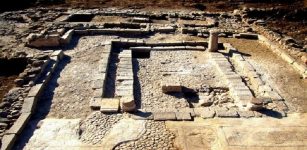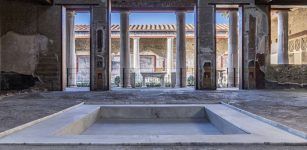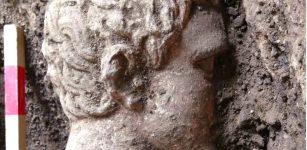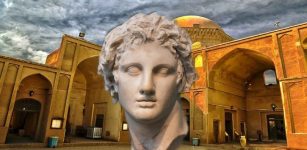Ancient Venetian Merchants Were Always Prepared For The Worst
Ellen Lloyd - AncientPages.com - Beautiful Venice in Italy is today recognized as one of the most charming cities in the world, and its ancient history is just as fascinating as this magnificent place's unique atmosphere.
J.M.W. Turner - Venice, The Dogana and San Giorgio Maggiore, 1834 - Credit: Public Domain
"In 1581, Francesco Sansovino, a Venetian who greatly admired his city, wrote that the name Venice derived from the Latin phrase Venietiam, which he said meant "come back again, and again, for however many times you come you will always see new and beautiful things." 1
This assumption concerning the origin of the name may not be accurate, but many still think Venice is like no other city in the world.
While strolling along the picturesque streets or enjoying the ride in a gondola, one can recall the daily life of 13th-century Venetian merchants who sometimes faced many dangers in the city.
A long time ago, Venice was merely a fishing village, but this small settlement eventually became one of Europe's most powerful states.
As John D. Irany writes in his book Venice in History, "the history of Venice is about simple things: the price of cloth, the design of ships, the transportation of spices and other goods. And it is about how such simple things affect the power and prosperity of nations. Like the Venetians themselves, we must approach their history from a worldview.
For hundreds of years, Venice was rich when the nations of the rest of Europe were poor. While London, Paris, and Rome were mired in the Dark Ages of Medievalism, the Republic of Venice–the Serene Republic–expanded in commerce, art, learning, and power. As such, Venice played a crucial role in the dynamic development of Europe.
In time, the changing fortunes of world events would allow other nations to challenge Venice's pre-eminent status successfully.
Bassanio, a theatrical character in Shakespeare's play "The Merchant of Venice" - Credit: Public Domain
But five hundred years ago, and for a thousand years before Columbus set sail to find a westward route to Asia, the Republic of Venice was the most exciting place. The citizens of the European nations that would later become great powers—England, France, Spain, and the Netherlands—could look only wistfully at the prosperity and wealth of the Venetians.
The Venetians readily expended their wealth on artistic and scientific achievement. Bellini, Tintoretto, Giorgione, and Titian were great masters of painting. The architects Andrea Palladio, Baldassare Longhena, and Jacopo Sansovino created churches, palaces, and even administrative offices of unsurpassed beauty. Galileo made his first astronomical discoveries while a professor at the Republic's university and later referred to his time in Venice as "the happiest years of his life."
With seemingly inexhaustible economic resources and unabated confidence in a bountiful future, Venetians built the glorious city that captivates all who see it, even today. In art, architecture, and scientific accomplishment, Venice in its time was the center of the world." 1
Though all this may give a glorying picture of Venice, one must remember life for the city's merchants during the 13th century was not always a luxury. During the 13th century, Italy was a collection of independent city-states, and to survive and prosper as a Venetian merchant, one had to have influential contacts or be friends with the most powerful families.
Using conflicts and wars to one's advantage could make a person tremendously rich. The Crusaders needed horses, soldiers, and ships. A cunning merchant would do all he could to offer transport and supplies at the highest possible price. This may sound a bit heartless, but a merchant's good life could change quickly because a failed harvest and the spread of diseases could end prosperity for a long time. Rivals and competition were a re-occurring problem in a place like Venice because this was "the city of choice for many merchants who utilized its European and Asian trade in the Holy Roman and Byzantine Empires." 2
Knowledge of the best trade routes was of utter importance if one wished to be successful, so merchants always wore a compass. Profitable goods, such as silk and spices, were highly desired products of Asia, but sweet Greek wine was also in high demand.
Even today, the first impression is often said last, and Venetian merchants take no risks when dealing with their clients. Wearing clean and fashionable clothes was a sign of confidence meant to reflect a trustworthy business person. Violence was naturally not uncommon, and carrying a dagger and a good sword was necessary. It happened when a merchant's ship or goods were stolen, and one had to defend property and sometimes life.
One can easily say Venetian merchants had to be prepared for the worst and always on their guard. Still, looking through our modern eyes, one cannot help wondering if this could have occasionally been forgotten in such a beautiful city as Venice.
Written by Ellen Lloyd – AncientPages.com
First version of this article was published on January 13, 2022
Copyright © AncientPages.com All rights reserved. This material may not be published, broadcast, rewritten or redistributed in whole or part without the express written permission of AncientPages.com
Expand for references- John D Irany - Venice in History: A History of the Serene Republic for Travelers
- Kevin McGivern – Trade, All About History, Issue 033
More From Ancient Pages
-
 Evidence The Khufu Channel Aided The Construction Of The Giza Pyramids Found – Scientists Say
Archaeology | Aug 31, 2022
Evidence The Khufu Channel Aided The Construction Of The Giza Pyramids Found – Scientists Say
Archaeology | Aug 31, 2022 -
 Mystery Of The Watchers And Book Of Enoch – Fallen Angels And Their Secret Knowledge
Biblical Mysteries | Oct 27, 2017
Mystery Of The Watchers And Book Of Enoch – Fallen Angels And Their Secret Knowledge
Biblical Mysteries | Oct 27, 2017 -
 Unexplained Mysteries Of The Superstition Mountains – A Gateway To Other Worlds?
Featured Stories | Dec 15, 2020
Unexplained Mysteries Of The Superstition Mountains – A Gateway To Other Worlds?
Featured Stories | Dec 15, 2020 -
 Celts In Poland: Iron Smelting Furnaces Used By Celts 2,400 Years Ago – Unearthed
Archaeology | Nov 30, 2019
Celts In Poland: Iron Smelting Furnaces Used By Celts 2,400 Years Ago – Unearthed
Archaeology | Nov 30, 2019 -
 2,000-Year-Old Ruins In Mary Magdalene’s Town Of Magdala On The Shore Of The Sea Of Galilee
Biblical Mysteries | Dec 26, 2014
2,000-Year-Old Ruins In Mary Magdalene’s Town Of Magdala On The Shore Of The Sea Of Galilee
Biblical Mysteries | Dec 26, 2014 -
 3,000-Year-Old Fortress Built By The Mysterious Votadini Tribe Discovered On Top Of Arthur’s Seat
Archaeology | Sep 11, 2020
3,000-Year-Old Fortress Built By The Mysterious Votadini Tribe Discovered On Top Of Arthur’s Seat
Archaeology | Sep 11, 2020 -
 Ancient Manuscript Reveals: Jesus Was Married And Fathered Two Children With Mary Magdalene
Archaeology | Nov 10, 2014
Ancient Manuscript Reveals: Jesus Was Married And Fathered Two Children With Mary Magdalene
Archaeology | Nov 10, 2014 -
 Look Inside A Restored Pompeii House – A Unique Glimpse Into Life In Italy’s Ancient City
Archaeology | Jan 11, 2023
Look Inside A Restored Pompeii House – A Unique Glimpse Into Life In Italy’s Ancient City
Archaeology | Jan 11, 2023 -
 Incredibly Well-Preserved 2,000-Year-Old Statue Of Greek God Hermes Found In Heraclea Sintica, Bulgaria
Archaeology | Jul 12, 2024
Incredibly Well-Preserved 2,000-Year-Old Statue Of Greek God Hermes Found In Heraclea Sintica, Bulgaria
Archaeology | Jul 12, 2024 -
 Curious Alien-Looking Slit Gongs Figures From Vanuatu Allowed Villagers To Communicate
Ancient Traditions And Customs | Sep 24, 2018
Curious Alien-Looking Slit Gongs Figures From Vanuatu Allowed Villagers To Communicate
Ancient Traditions And Customs | Sep 24, 2018 -
 Powerful Winds In Ancient Beliefs
Featured Stories | Feb 5, 2024
Powerful Winds In Ancient Beliefs
Featured Stories | Feb 5, 2024 -
 DNA Offers Insights Into The Use Of Plants By Humans In The Paleolithic Age
Archaeology | Oct 13, 2022
DNA Offers Insights Into The Use Of Plants By Humans In The Paleolithic Age
Archaeology | Oct 13, 2022 -
 Etzanoa: Long-Lost Native American City Discovered In Kansas After 400 Years
Archaeology | Apr 24, 2017
Etzanoa: Long-Lost Native American City Discovered In Kansas After 400 Years
Archaeology | Apr 24, 2017 -
 Rare Viking Ship Burial At Gamla Uppsala Reveals Its Secrets – What’s Inside?
Archaeology | Aug 8, 2020
Rare Viking Ship Burial At Gamla Uppsala Reveals Its Secrets – What’s Inside?
Archaeology | Aug 8, 2020 -
 Mnemosyne: Powerful Greek Goddess Of Memory, Bridge Between The Past And The Future
Featured Stories | Aug 2, 2021
Mnemosyne: Powerful Greek Goddess Of Memory, Bridge Between The Past And The Future
Featured Stories | Aug 2, 2021 -
 Mystery Of Zendan-e Eskandar – Alexander The Great’s Prison
Featured Stories | Oct 14, 2020
Mystery Of Zendan-e Eskandar – Alexander The Great’s Prison
Featured Stories | Oct 14, 2020 -
 What Is The Avoidance Custom Of The Amish People In Pennsylvania?
Ancient History Facts | Jul 29, 2019
What Is The Avoidance Custom Of The Amish People In Pennsylvania?
Ancient History Facts | Jul 29, 2019 -
 Massive 2nd-Century Fountain In Turkey’s Ancient City Of Tripolis Will Be Soon Restored
Archaeology | Aug 3, 2020
Massive 2nd-Century Fountain In Turkey’s Ancient City Of Tripolis Will Be Soon Restored
Archaeology | Aug 3, 2020 -
 Tomb Of Christopher Columbus Finally Found But There Is One Problem With His Body
Archaeology | Apr 9, 2022
Tomb Of Christopher Columbus Finally Found But There Is One Problem With His Body
Archaeology | Apr 9, 2022 -
 On This Day In History: Malcolm III, King of Scots Died – On Nov 13, 1093
News | Nov 13, 2016
On This Day In History: Malcolm III, King of Scots Died – On Nov 13, 1093
News | Nov 13, 2016


